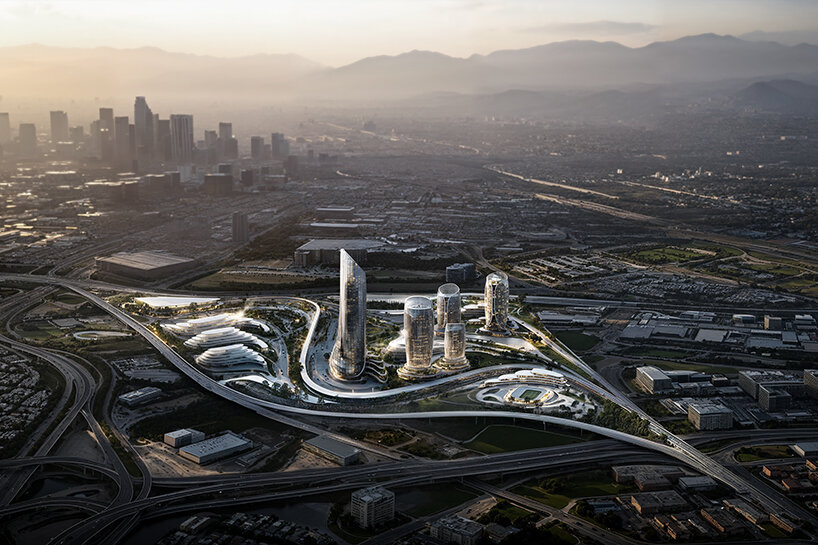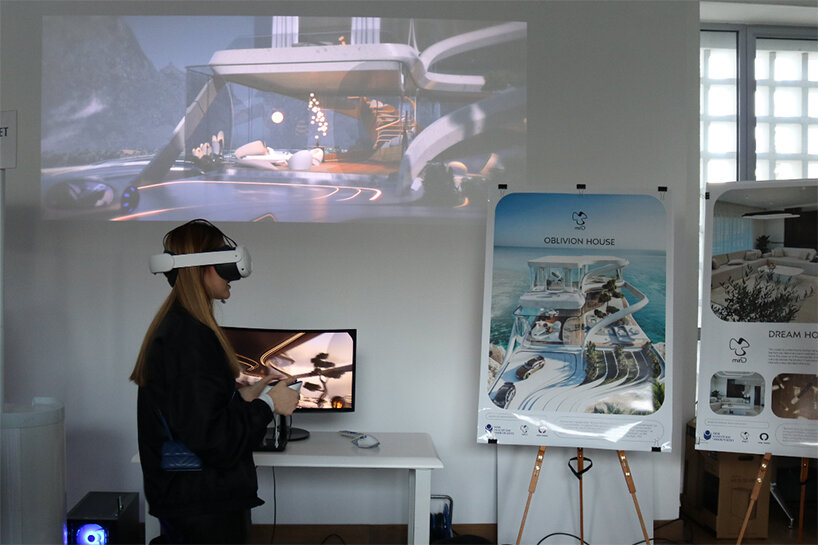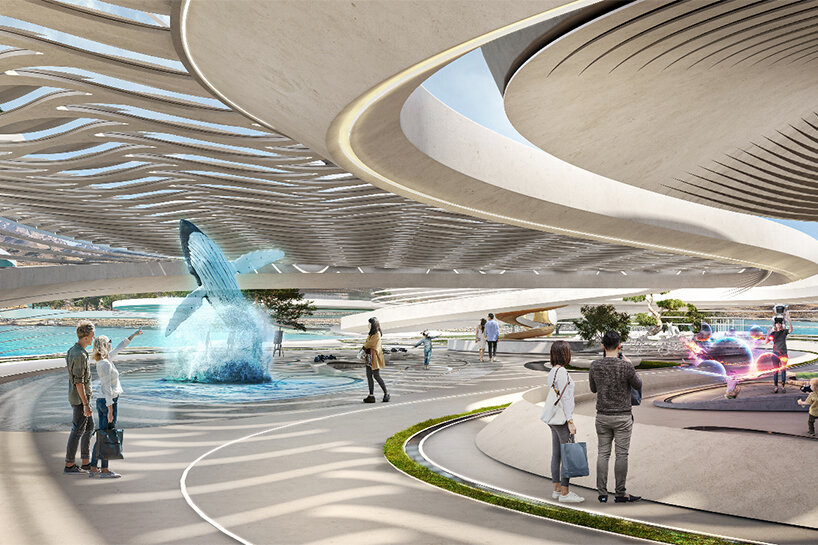new architectural methodology overlays craftsmanship with AI
Mind Design Studio, in collaboration with the digital platform Dom World, is developing a new architectural methodology that overlays traditional craftsmanship with immersive technologies and machine learning. Their work emerges from the belief that architecture can no longer operate in isolation from the digital and cultural forces transforming everyday experience, but it must evolve its practices without abandoning its principles. Through hybrid workflows that merge hand-modeled forms, real-time collaboration, and AI-driven iterations like Midjourney, the team is building environments that are both visually striking as well as emotionally resonant, participatory, and intelligent.

the vision of the LA28 Olympic Village, developed in collaboration with Studio Tim Fu, combining hand-modeled massing studies with AI-augmented iterations | image © Studio Tim Fu, all images courtesy of Mind Design Studio
transforming architecture into a living, participatory medium
Founded by Miroslav Naskov, who is also the co-founder of Dom World, Mind Design Studio is an experimental architecture and design practice based in London. The studio focuses on projects that fuse digital innovation with deeply human design values. Its work spans across architecture, immersive environments, and research-driven installations, exploring how emerging technologies, particularly AI, can coexist with intuitive, craft-based processes.
Through platforms like Dom World, the studio creates shared design experiences that transform architecture into a living, participatory medium. This topic matters now more than ever as the architecture field grapples with the increasing role of automation, the need for more inclusive design processes, and the call for emotionally intelligent spaces in both physical and digital realms. As Miroslav Naskov puts it, ‘This is where craft, play, and AI converge — not as tools, but as an integrated methodology.’

Stair Design at the intersection of craft, code, and play, blending tectonic clarity with generative logic | image © Mind Design
the fusion of hand sketching and AI refinement
Mind Design’s process begins with physical intuition. Using tools like Maya and Rhino, the team sketches by hand—sculpting curves and volumes that prioritize sensuality, beauty, and clarity. These forms aren’t just geometry, they are expressions of emotional intent, shaped with precision and passion, making design a way of thinking through making, allowing the studio to shift between the physical and digital, abstract and built. ‘We use curves not just for geometry, but for their sensual quality, searching for legibility in new ideas, for pure beauty driven by nature,’ explains the founder of Mind Design and co-founder of Dom World.
Once these early models take form, the studio incorporates AI platforms such as Midjourney, Runway, Kling, and mnmi to explore a wider set of possibilities. ‘AI doesn’t replace intuition — it expands it. The hand still leads, but the machine helps it see further,’ adds Naskov. But the final result is always guided by the designer’s eye, making this hybrid process a fluid, iterative workflow that is analytical yet poetic, computational yet crafted.

Art Of Emotive Architecture Exhibition, an interactive exhibition collecting real-time participant feedback to shape spatial design logic | image © Mind Design
Architecture, in this methodology, becomes a space for dialogue. Instead of presenting static renderings, Mind Design brings concepts into Dom World – the multiplayer digital environment where teams, clients, and collaborators can enter and experience designs together. This transforms architectural development into something collective and open-ended where visualization becomes a laboratory for shared exploration and not just a tool.
In Dom World, decisions are shaped through interaction. Adaptive features powered by AI personalize the experience, suggest refinements, and keep the process responsive. The space itself becomes a playground for design thinking, one where users move freely, test ideas, and generate insight. During the Play phase, feedback isn’t added at the end but built into the beginning; this is how Mind Design reframes authorship – they don’t just design for people, they design with them.

Future Of Learning seen in a multiplayer environment where education becomes an immersive adventure | image © nVisual Studio
AI plays a dual role in this process both as a generative tool, and as a learning system. After every interactive session, the studio collects real-time feedback, seeing how participants move, respond, or engage with the space, and feeds it back into their AI models. The system then refines its logic, identifies patterns, and informs future iterations. Over time, the process becomes more intelligent and more adaptive.
Rather than diminishing the designer’s role, this feedback loop enhances it and AI becomes a collaborator that provides insight, optimizing decisions, and supporting emotional and functional clarity in the final design. As seen in their work on the LA28 Olympic Village (developed in collaboration with Studio Tim Fu), and projects shown at Venice Design Week, Mind Design demonstrates how AI can expand authorship rather than dilute it. Through sculptural clarity and computational logic, they are pushing the boundaries of what architecture can be.

